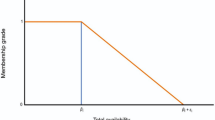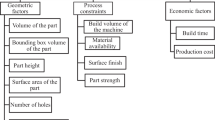Abstract
This paper introduces a new fuzzy mathematical model based on the fuzzy parametric programming (FPP) approach for the cellular manufacturing system (CMS) design. The aim of the proposed model is to handle two important problems of CMS design called cell formation (CF) and exceptional elements (EE) simultaneously in fuzzy environment. The model is capable to express vagueness of all the system parameters and gives the decision-maker (DM) alternative decision plans for different grades of precision. So, it is expected to provide a more realistic CMS design for real life problems. To illustrate the model proposed here, an example with fuzzy extension in data set is adopted from literature and computational results are presented.
Similar content being viewed by others

References
B.D. Arieh Triantaphyllou (1992) ArticleTitleQuantifying data for group technology with weighted fuzzy features International Journal of Production Research 30 IssueID6 1285–1299
A. Brooke D. Kendrick A. Meeraus (1988) GAMS-The General Algebraic Modelling System, A User’s Guide The Scientific Press USA
C. Carlsson P. Korhonen (1986) ArticleTitleA parametric approach to fuzzy linear programming Fuzzy Sets and Systems 20 17–30
C. H. Cheng A. Kumar J. A. Motwani (1995) ArticleTitleCom- parative examination of selected cellular manufacturing clustering algorithms International Journal of Operations and Production Management 15 86–97
C. H. Chu J. C. Hayya (1991) ArticleTitleA fuzzy clustering approach to manufacturing cell formation International Journal of Production Research 29 IssueID7 1475–1487
A. Gill C. R. Bector (1997) ArticleTitleA fuzzy linguistic approach to data quantification and construction of distance measures for part family formation problem International Journal of Production Research 35 IssueID9 2565–2578
Z. Güngör F. Arı ıkan (2000) ArticleTitleApplication of fuzyy decision making in part machine grouping International Journal of Production Economics 63 181–193
S. S. Heragu (1994) ArticleTitleGroup technology and cellular manufacturing IEEE Transactions on System, Man and Cybernetics 24 IssueID2 203–214
G. M. Kern J. C. Wei (1991) ArticleTitleThe cost of eliminating exceptional elements in group technology cell formation International Journal of Production Research 29 IssueID8 1535–1547
Y. J. Lai C. L. Hwang (1992) Fuzzy Mathematical Programming-methods and applications Springer-Verlag Berlin, Germany
A. Masnata I. Settineri (1997) ArticleTitleAn application of fuzzy clustering to cellular manufacturing International Journal of Production Research 35 IssueID4 1077–1094
C. Mosier L. Taube (1985) ArticleTitleThe facets of group technology and their impacts on implementation-A state of the art survey Omega 13 IssueID5 381–391
O. F. Offodile A. Mehrez J. Grznar (1994) ArticleTitleCellular manufacturing: A taxonomic review framework Journal of Manufacturing Systems 13 IssueID3 196–220
H. Seifoddini (1989) ArticleTitleDuplication process in machine cell formation in group technology IIE Transactions 21 382–388
H. M. Selim R. G. Askin A. J. Vakharia (1998) ArticleTitleCell formation in group technology: Review, evaluation and directions for future research Computers Industrial Engineering 34 IssueID1 3–20
S. M. Shafer G. M. Kern J. C. Wei (1992) ArticleTitleA mathematical programming approach for dealing with exceptional elements in cellular manufacturing International Journal of Production Research 30 IssueID5 1029–1036
R. Shanker P. Vrat (1999) ArticleTitleSome design issues in cellular manufacturing using the fuzzy programming approach International Journal of Production Research 37 IssueID11 2545–2563
N. Singh (1993) ArticleTitleDesign of cellular manufacturing systems: An invited review European Journal of Operational Research 69 284–291
C. C. Tsai C. H. Chu T. A. Barta (1997) ArticleTitleModelling and analysis of a manufacturing cell formation problem with fuzzy mixed integer programming IIE Transactions 29 533–547
U. Wemmerlöv N. L. Hyer (1986) ArticleTitleProcedures for the part family/machine group identification problem in cellular manufacturing Journal of Operations Management 6 IssueID2 125–147
L. A. Zadeh (1965) ArticleTitleFuzzy sets Information and Control 8 338–353
C. Zang H. P. Wang (1992) ArticleTitleConcurrent formation of part family and machine cells based on fuzzy set theory Journal of Manufacturing Systems 11 61–67
Author information
Authors and Affiliations
Corresponding author
Rights and permissions
About this article
Cite this article
Arikan, F., Güngör, Z. A parametric model for cell formation and exceptional elements’ problems with fuzzy parameters. J Intell Manuf 16, 103–114 (2005). https://doi.org/10.1007/s10845-005-4827-3
Issue Date:
DOI: https://doi.org/10.1007/s10845-005-4827-3



